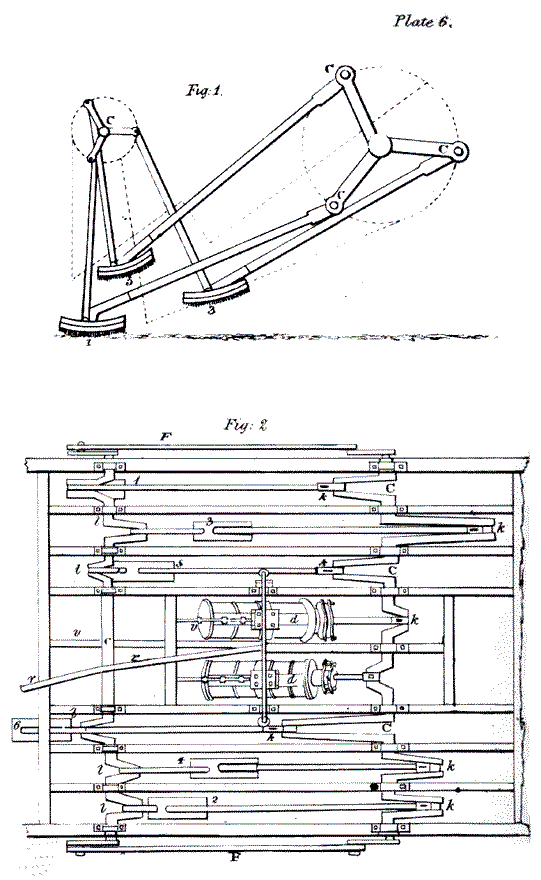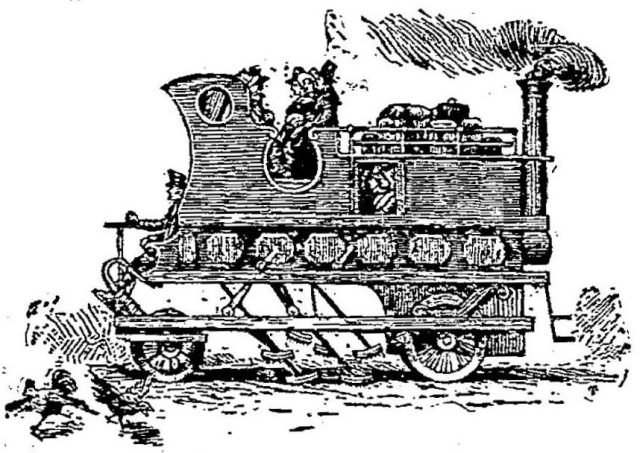


THE LIFE AND TIMES OF SIR GOLDSWORTHY GURNEY
Chapter 5: INVENTING THE STEAM CARRIAGE p77In 1824 David Gordon tried again with "an arrangement of machinery, by which an action similar to horses' feet could be obtained." Six jointed iron legs, fitted with feet, were connected by brass joints, straps, and keys to a set of cranks, propelled by a pair of steam engines. The legs extended through the floor in the middle of the carriage, analogous to the legs of a horse, and the feet pushed backwards on the road to move the carriage forward. This astonishing arrangement had been tried by other inventors before Gordon. It was regarded as quite promising despite its ungainly, clattering features. After Gordon applied to Gurney for permission to use one of his light tubular boilers, Gurney adapted Gordon's machinery for his own carriage, constructing a set of smaller legs to be used as supplementary traction when going up hills. The legs, or "propellers," were attached to parallel wooden blocks that slid back and forth in metal grooves, in alternate strokes, underneath the carriage. In his first experiment with a full-size carriage, Gurney used the propellers to ascend Windmill Hill. He found them inconvenient and heavy, but still believed they were necessary for the purpose. Indeed, several scientific journals had just published papers demonstrating that "fact" with mathematical formulas. However, "after much thought and experiment," as Gordon reported it, Gurney devised a mechanism that would bring the propellers into action only when the wheels slipped. With this in place, he launched a second run of nine and a half miles between his Oxford Street factory and Edgware. Much to his surprise, the ordinary carriage wheels maintained excellent traction, even when going up considerable inclines. The whole phenomenon of slippage, he discovered, resulted from the sudden impact on wheels by the large cylinders of older high-pressure engines. Because his locomotive increased steam pressure gradually by means of a throttle, it eliminated the shock. Gurney apparently kept the propellers for a while, expecting that they would be necessary in case of mud or snow, but after several more trials, they were abandoned. In later evidence before Parliament, he claimed that he had used his carriage on both snow and ice, with few problems." After the Windmill Hill—Edgware trials, the rear carriage wheels were driven by a crankshaft attached directly to the dual pistons of the engine, and in fact, power was commonly directed to only one wheel at a time. Although hundreds of people witnessed these trials, and although they were reported in the local press, some mechanics still refused to believe the results. One of these was John Farey (17911851), a civil engineer experienced with steam engines, who had prepared the drawings for Gurney's original "propeller" patent. Farey evidently changed his mind, because he later adapted the Gurney design to a steam carriage of his own.
The steam for Gurney's first carriage was generated by a large drum boiler, common to most engines at that time. The design had two drawbacks, which he and other inventors worked to overcome. First, the boiler was heavy, especially when filled with water. It added significantly to the weight oi the carriage and ate up its own energy in moving forward. This was not a problem on rails, which reduced friction to negligible proportions, but it proved impossible on gravel roads. Second, the boiler was likely to explode. As hot water rose in the boiler, cold water descended along unpredictable pathways. Heat and cold, water and steam were often distributed unevenly around the inside of the boiler, causing "hot spots" to form and burst. Also, the evaporation of the steam left a residue, or crust, called fur, which collected near the bottom of the boiler where the flame struck its surface. The fur caused further irregular heating and eventually ate through the metal. Filtering the water did not solve this problem; the residue was chemically dissolved in the water to start with, and, after it was deposited, it could not be removed except with hammer and chisel or a rough rake. Moreover, Gurney had discovered in the course of his chemistry research that small amounts of water in a hot boiler actually decomposed. Combining with nitrogen in the atmosphere, they formed new, highly volatile compounds. Most inventors of the time simply ignored the problem of safety. They aimed to reduce the weight of the boiler, hoping, as Alexander Gordon acidly commented, that the skill of the engineer, or sheer luck, would prevent explosions, or that if one occurred, it would be "attended by death only to some of those whose situation could be supplied on the morrow at equally low wages."